.
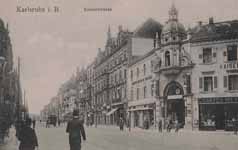
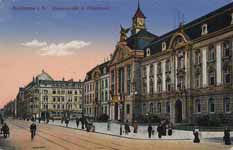
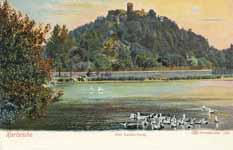

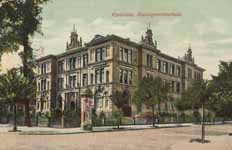
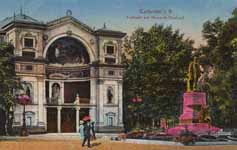
7, 8, 9,
10, 11,
Karlsruhe
The City of Karlsruhe (German pronunciation: [ˈkaɐ̯lsʁuːə]; formerly Carlsruhe) is a city in the southwest of Germany, in the state (bundesland) of Baden-Württemberg, located near the French-German border.
Karlsruhe was founded in 1715 as Karlsruhe Palace, when Germany was a series of principalities and city states. The town surrounding the Palace became the seat of two of the highest courts in Germany, the Federal Constitutional Court of Germany (Bundesverfassungsgericht) whose decisions have the force of a law in many cases, and the Federal Court of Justice of Germany (Bundesgerichtshof), the highest court of appeals in matters of civil law and criminal law. It therefore considers itself the home of justice in Germany, a role taken over from Leipzig after 1945.[2][3]
Due to similarities to the United States capital city, it has been speculated that Karlsruhe was a model city for the cityscape of Washington, D.C.[4] Both cities have a center — in Karlsruhe the palace and in D.C. the Capitol Building — from which the streets radiate outward. L'Enfant, Washington's city planner, had been given the plans of Karlsruhe (among numerous other European cities) as an inspiration.[5][dead link]
Geography
The 49th parallel north in the Karlsruhe Stadtgarten
The city lies at an altitude between 100 m (on the eastern shore of the river Rhine) and 322 m (near the TV Tower). Its geographical coordinates are 49°00′N 8°24′E; the 49th parallel runs through the city centre. Its course is marked by a stone and painted line in the Stadtgarten (city park).
MiRO oil refinery
The city was planned with the palace tower (Schloss) at the center and 32 streets radiating out from it like the spokes of a wheel, or the ribs of a folding fan, so that one nickname for Karlsruhe in German is the "fan city" (Fächerstadt). Almost all of these streets survive today. Because of this city layout, in metric geometry, Karlsruhe metric refers to a measure of distance that assumes travel is only possible along radial streets and along circular avenues around the center.[6]
The city centre is the oldest part of town and lies south of the palace in the quadrant defined by nine of the radial streets. The central part of the palace runs east-west, with two wings, each at a 45° angle, directed southeast and southwest respectively (i.e. parallel with the streets marking the boundaries of the quadrant defining the city center).
The market square lies on the street running south from the palace to Ettlingen. The market square has the town hall (Rathaus) to the west, the main Lutheran church (Evangelische Stadtkirche) to the east, and the tomb of Margrave Karl Wilhelm in a pyramid in the buildings, resulting in Karlsruhe being one of only three large cities in Germany where buildings are laid out in the Neoclassical style.
The area north of the palace is a park and forest. Originally the area to the east of the palace consisted of gardens and forests, some of which remain, but the Institute of Technology (founded in 1825), Wildparkstadion, and residential areas have been built there. The area west of the palace is now mostly residential.
Panorama of Karlsruhe, looking south from the palace tower . The Institute of Technology is on the left, the Market square in the centre, the Federal Constitutional Court on the right. Note wings of the palace aligning with streets, all radiating out from the centre of town (i.e. the palace tower).
Climate
Karlsruhe experiences an oceanic climate (Köppen climate classification Cfb) similar to much of Germany.
| Climate data for Karlsruhe | |||||||||||||
|---|---|---|---|---|---|---|---|---|---|---|---|---|---|
| Month | Jan | Feb | Mar | Apr | May | Jun | Jul | Aug | Sep | Oct | Nov | Dec | Year |
| Average high °C (°F) | 3.8 (38.8) |
6.1 (43.0) |
10.9 (51.6) |
15.4 (59.7) |
19.9 (67.8) |
23.0 (73.4) |
25.5 (77.9) |
25.1 (77.2) |
21.5 (70.7) |
15.3 (59.5) |
8.5 (47.3) |
4.8 (40.6) |
15.0 (59.0) |
| Average low °C (°F) | −1.4 (29.5) |
−0.7 (30.7) |
1.9 (35.4) |
4.9 (40.8) |
8.9 (48.0) |
12.2 (54.0) |
14.0 (57.2) |
13.8 (56.8) |
10.6 (51.1) |
6.7 (44.1) |
2.4 (36.3) |
−0.4 (31.3) |
6.1 (43.0) |
| Precipitation mm (inches) | 56 (2.2) |
53 (2.1) |
53 (2.1) |
61 (2.4) |
79 (3.1) |
86 (3.4) |
71 (2.8) |
66 (2.6) |
53 (2.1) |
58 (2.3) |
66 (2.6) |
66 (2.6) |
770 (30.3) |
| Source: Intellicast[7] | |||||||||||||
History
According to legend, the name Karlsruhe, which translates as Charles’ repose, was given to the new city after a hunting trip when Margrave Charles III William, Margrave of Baden-Durlach, woke from a dream in which he dreamt of founding his new city.
Charles William founded the city on June 17, 1715 after a dispute with the citizens of his previous capital, Durlach. The founding of the city is closely linked to the construction of the palace. Karlsruhe became the capital of Baden-Durlach and in 1771 of the united Baden until 1945. Built in 1822, the "Ständehaus" was the first parliament building in a German State. In the aftermath of the democratic revolution of 1848, a republican government was elected here.
In 1860 the first ever international professional convention, the Karlsruhe Congress, was held in the city.
Much of the central area, including the palace, was reduced to rubble by Allied bombing during World War II but was rebuilt after the war.
Main sights
The Durlacher Turmberg has a look-out tower (hence its name). It is a former keep dating back to the 13th century.
The Stadtgarten is a recreational area near the main railway station (Hauptbahnhof) and was rebuilt in 1967 during the 'Federal Garden Show' (Bundesgartenschau). It is also the site of the Karlsruhe Zoo.
The city has two botanical gardens: the municipal Botanischer Garten Karlsruhe which forms part of the Palace complex, and the Botanischer Garten der Universität Karlsruhe which is maintained by the university.
The Marktplatz has a the stone pyramid marking the grave of the city's founder. Built in 1825, it is the emblem of Karlsruhe. The city is nicknamed the fan city (Die Fächerstadt) because of its design layout, with straight streets radiating fan-like from the Palace.
The Karlsruhe Palace (Schloss) is an interesting piece of architecture; the adjacent Schlossgarten includes the Botanical Garden with a palm, cactus and orchid house, and walking paths through the woods to the north.
The so-called Kleine Kirche (Little Church), built between 1773 and 1776, is the oldest church of Karlsruhe's city centre.
The architect Friedrich Weinbrenner designed many of the city's most important sights. Another sight is the Rondellplatz with its 'Constitution Building Columns' (1826). It is dedicated to Baden's first constitution in 1818, which was one of the most liberal of its time. The Münze (mint), erected in 1826/27, was also built by Weinbrenner.
St. Stephan
The St. Stephan parish church is one of the masterpieces of neoclassical church architecture in Southern Germany. Weinbrenner, who built this church between 1808 and 1814, orientated it to the Pantheon, Rome.
Burial chapel
The neo-gothic Grand Ducal burial chapel, built between 1889 and 1896, is a mausoleum rather than a church, and is located in the middle of the forest.
The main cemetery of Karlsruhe is the oldest park-like cemetery in Germany. The crematorium was the first to be built in the style of a church.
Karlsruhe is also home to a Museum of Natural History, an opera house (the 'Baden State Theatre'), as well as a number of independent theatres and art galleries. The State Art Gallery, built in 1846 by Heinrich Hübsch, displays paintings and sculptures from six centuries, particularly from France, Germany and Holland. Karlsruhe's newly renovated art museum is one of the most important art museums in Baden-Württemberg. Further cultural attractions are scattered throughout Karlsruhe's various incorporated suburbs. The Scheffel Association or literary society (established in 1924), is the largest literary organisation in Germany.[citation needed] Today the Prinz-Max-Palais, built between 1881 and 1884 in neoclassical style, houses the organisation and includes its museum.
Breweries and buildings in art nouveau style were predominant in the western city
Due to population growth in the later 19th Century, Karlsruhe developed several suburban areas (Vorstadt) in the Gründerzeit and especially Art nouveau styles of architecture, with many preserved examples.
Karlsruhe is also home to the Majolika-Manufaktur,[8] the only art-ceramics pottery studio in Germany.[citation needed] Founded in 1901, it is located in the Schlossgarten. A 'blue streak' (Blauer Strahl) consisting of 1645 ceramic tiles, connects the studio with the Palace. It is the world's largest ceramic artwork.[citation needed]
Another tourist attraction is the Centre for Art and Media (Zentrum für Kunst und Medientechnologie, or ZKM), which is located in a converted ammunition factory.
Government
Justice
The Federal Constitutional Court of Germany
Karlsruhe is the seat of the German Federal Constitutional Court (Bundesverfassungsgericht) and the highest Court of Appeals in civil and criminal cases, the Bundesgerichtshof. The court came to Karlsruhe when the provinces of Baden and Württemberg were merged. Stuttgart, capital of Württemberg, became the capital of the new province, and Karlsruhe was given the high court in a compromise.
Public health
There are four hospitals: The municipal Klinikum Karlsruhe provides the maximum level of medical services, the St. Vincentius-Kliniken and the Diakonissenkrankenhaus, connected to the Catholic and Protestant churches, respectively, offer central services, and the private Paracelsus-Klinik basic medical care, according to state hospital demand planning.
Economy
Germany's largest oil refinery is located in Karlsruhe, at the western edge of the city, directly on the river Rhine.
The Technologieregion Karlsruhe is a loose confederation of the region's cities in order to promote high tech industries; today, about 20% of the region's jobs are in Research and Development which gives a good basis for high tech.
Internet activities
Due to the University of Karlsruhe providing services until the late 1990, Karlsruhe became known as the internet capital of Germany. The DENIC, Germany's Network Information Centre, has since moved to Frankfurt, though, where DE-CIX is located.
Two major internet service providers, WEB.DE and schlund+partner/1&1, now both owned by United Internet AG, are located at Karlsruhe.
The Stadtwiki Karlsruhe is the biggest city wiki in the world.
The library of the Karlsruhe Institute of Technology developed the Karlsruher Virtueller Katalog, the first internet site that allowed researchers worldwide (for free) to search multiple library catalogues worldwide.
In the year 2000 the regional online "newspaper" ka-news.de was created. As a daily news paper it's not only providing news, but informs also about upcoming and current events in Karlsruhe and the surrounding area.
Rail yard, bypass road Südtangente
Transport
The Verkehrsbetriebe Karlsruhe (VBK) operates the city's urban public transport network, comprising seven tram routes and a network of bus routes. This network is well developed and all city areas can be reached 24/7 by tram and a night bus system. The Turmbergbahn funicular railway, to the east of the city centre, is operated by the VBK.
The VBK is also a partner, with the Albtal-Verkehrs-Gesellschaft and Deutsche Bahn, in the operation of the Karlsruhe Stadtbahn, the rail system that serves a larger area around the city. This system makes it possible to reach other towns in the region, like Ettlingen, Wörth am Rhein, Pforzheim, Bad Wildbad, Bretten, Bruchsal, Heilbronn, Baden-Baden and even Freudenstadt in the Black Forest right from the city centre. The Stadtbahn is well known in transport circles around the world for pioneering the concept of operating trams on train tracks, to achieve a more effective and attractive public transport system, to the extent that this is often known as the Karlsruhe model tram-train system.
Karlsruhe is well-connected via road and rail, with Autobahn and InterCityExpress connections going to Frankfurt, Stuttgart/Munich and Freiburg/Basel. Since June 2007 it has been connected to the TGV network, reducing travel time to Paris to only three hours (compared to 5 hours previously).
Oil port
Two ports on the Rhine provide transport capacity on cargo ships, especially for petroleum products.
The nearest airport is part of the Baden Airpark (officially Flughafen Karlsruhe/Baden-Baden) about 45 km (28 mi) southwest of Karlsruhe, with regular connections to airports in Germany and Europe in general. Frankfurt International Airport can be reached in about an hour and a half by car (one hour by InterCityExpress); Stuttgart Airport can be reached in about one hour (about an hour and a half by train and S-Bahn).
Two interesting facts in transportation history are that both Karl Drais, the inventor of the bicycle, as well as Carl Benz, the inventor of the car were born in Karlsruhe and that Benz also studied at the city’s university; and that Benz’s wife Bertha took the world's first long distance-drive with a car from Mannheim to Karlsruhe-Grötzingen and Pforzheim (see Bertha Benz Memorial Route). Their professional lives led both men to the neighboring city of Mannheim, where they first applied their most famous inventions.
Memorial for Baden Life Grenadiers in several wars, 1803–1918
Karlsburg Castle in Durlach
Jewish community
Jewish cemetery of Grötzingen
Jews settled in Karlsruhe since its foundation. They were attracted by the numerous privileges granted by its founder to settlers, without discrimination as to creed. Official documents attest the presence of several Jewish families at Karlsruhe in 1717. A year later the city council addressed to the margrave a report in which a question was raised as to the proportion of municipal charges to be borne by the newly arrived Jews, who in that year formed an organized congregation, with Rabbi Nathan Uri Kohen of Metz at its head. A document dated 1726 gives the names of twenty-four Jews who had taken part in an election of municipal officers. As the city grew permission to settle there became less easily obtained by Jews, and the community developed more slowly. A 1752 Jewry ordinance stated Jews were forbidden to leave the city on Sundays and Christian holidays, or to go out of their houses during church services, but they were exempted from service by court summonses on Sabbaths. They could sell wine only in inns owned by Jews and graze their cattle, not on the commons, but on the wayside only. Karlsruhe was the seat of the central council of Baden Jewry. The first chief rabbi of the country Rabbi Asher Lowe was from (Durlach) Karlsruhe, Nethaneel Weil was a rabbi in Karlsruhe from 1750 until his death.
First synagogue, built by Friedrich Weinbrenner in 1806, existed until 1871
In 1783, by a decree issued by Margrave Charles Frederick of Baden, the Jews ceased to be serfs, and consequently could settle wherever they pleased. The same decree freed them from the "Todfall" tax, paid to the clergy for each Jewish burial. In commemoration of these changes special prayers were prepared by the acting rabbi Jedidiah Tiah Weill, who, succeeding his father in 1770, held the office until 1805. In 1808 the government issued regulations concerning the administration of the spiritual affairs of the Jewish community, by which the chief rabbi of Karlsruhe became the spiritual head of the Jews of the country. Complete emancipation was given in 1862, Jews were elected to city council and Baden parliament, and from 1890 were appointed judges. Jews were persecuted in riots occurring in 1819 and anti-Jewish demonstrations were held in 1843, 1848, and the 1880s. The well-known German-Israeli artist Leo Kahn studied in Karlsruhe before leaving for France and Israel in the 1920s and '30s.
Public hanukkah on the Schlossplatz
Today, there are about 900 members in the Jewish community, many of whom are recent immigrants from Russia, and a Chabad rabbi.[9]
Karlsruhe has memorialized its Jewish community and notable pre-war synagogues with a memorial park.[10]
Karlsruhe and the Holocaust
The new synagogue
In 1933, 3,358 Jews lived in Karlsruhe. The community owned buildings and property, such as two synagogues, one on Karl-Friedrich-Straße and one on Kronenstraße, two elderly citizens' homes, a Jewish school, a hospital, welfare institutions and several Jewish cemeteries. During the first years of the Nazi regime, the community continued to function, particularly to prepare Jews for emigration. On October 28, 1938, all male Polish Jews living in Karlsruhe were deported to Poland. Synagogues were destroyed on Kristallnacht, 9–10 November 1938. Most of the men were arrested and sent to Dachau concentration camp, but were released after they had furnished proof that they intended to emigrate. In October 1940, 895 Jews were expelled during Operation Wagner-Bürckel and interned by the French Vichy authorities in Gurs in southern France. Most of these were then deported from there to Auschwitz (via the Drancy deportation camp, on the outskirts of Paris) between August and November 1942. Most of the 429 remaining Jews and other so-called "non-Aryans" were deported to the east between 1941 and 1944. In 1945 there were only 18 Jews in Karlsruhe. More than 1,000 of them had been killed between 1933 and 1945.[11] The Baden Central Jewish Council was reorganized in 1948. A new synagogue was built in 1969.
Historical population
Year Inhabitants
1719 2,000[12]
1750 2,500[12]
1815 >15,000[12]
1901 100,000[12]
1933 155,000[12]
1973 264,249[13]
2003 282,595
2007 288,917
Famous people
Dennis Aogo, German football defender currently plays for Hamburger SV
Victoria of Baden (1862–1930), born in Karlsruhe, Queen consort of Sweden by her marriage to King Gustaf V of Sweden.
Female Bodybuilding legend Christa Bauch hails from Karlsruhe.
Hermann Billing, Art Nouveau architect, was born and lived in Karlsruhe and built his first famous works here.
Karoline von Günderrode, a German poet, was born in Karlsruhe (1780–1806).
Karl Drais, inventor of the two-wheeler principle basic to bicycle and motorcycle, key typewriter and earliest stenograph, was born and died in Karlsruhe (1785–1851)
Mühlburg, since 1886 a borough of Karlsruhe, is the birthplace of Karl Benz (1844–1929), inventor of the automobile and founder of Benz & Co., now part of Daimler AG (formerly Daimler-Benz)
Walther Bensemann is one of the founders of the first southern German soccer club Karlsruher FV and later he became one of the founders of DFB and the founder of Kicker, which still is Germanys leading soccer magazine.
Oliver Bierhoff, retired German football striker and former national team captain for the Germany and Italian Serie A clubs Udinese, A.C. Milan and Chievo; currently working as the German national team manager
Siegfried Buback then Attorney General of Germany fell victim to terrorists of the Rote Armee Fraktion in April 1977.
Andi Deris, lead singer of the power metal band Helloween, was born in Karlsruhe.
Theodor von Dusch (1824–1890), physician remembered for experiments involving cotton-wool filters for bacteria.
Ludwig Eichrodt, writer
Obergruppenführer SS Hans Frank (1900–1946), Gauleiter and governor general of Nazi occupied Poland
Reinhold Frank, a German lawyer who worked for the resistance in Nazi Germany, ran a law practice in Karlsruhe. In his honour the street in Karlsruhe where the lawyers´chambers was founded bears his name.
Gottfried Fuchs was born in Karlsruhe and holds the record of 10 goals in one single international soccer match for the German national team.
Regina Halmich, the current female boxing flyweight world champion, is a native of Karlsruhe, too.
Johann Peter Hebel, writer and poet, lived in Karlsruhe for most of his life.
In the late 1880s, professor Heinrich Rudolf Hertz discovered electromagnetic waves at the University of Karlsruhe; today, a lecture room named after Hertz lies close by the very spot where the discovery was made.
Friedrich Hund a physicist of the pioneering generation of quantum mechanics (see Hund's rules) was born here.
Oliver Kahn, retired goalkeeper of Bayern Munich and Germany was also born in this city, in 1969.
Sebastian Koch was born May 31, 1962 in Karlsruhe. He is a German actor.
Gustav Landauer, one of the leading theorists of anarchism in Germany, was born in Karlsruhe.
Renate Lingor, former German national football player.
Vincenzo Italiano, Italian footballer currently plays for Calcio Padova
Markus Lüpertz worked and lives in Karlsruhe. He has created the “Narrenbrunnen” (Fool's Fountain) in the city center.
Composer Wolfgang Rihm is a resident of Karlsruhe
In 1886, Joseph Viktor von Scheffel, a German poet and novelist, was born in Karlsruhe.
Peter Sloterdijk, philosopher and current president of the State Academy of Design
Mehmet Scholl, retired footballer for Bayern and the German national team
Muhammed Suiçmez, guitarist and composer for German technical death metal band Necrophagist was born in Karlsruhe on November 23, 1975.
Johann Gottfried Tulla, born on March 20, 1770 in Karlsruhe and died on March 27, 1828 in Paris. Tulla studied engineering at the Mining Academy in Freiberg (Saxony) during the 1790s. From 1817 on, Tulla was instrumental in stabilizing and straightening the course of the southern Rhine River, a project that continued until 1879. Tulla was also a co-founder of the Technical University in Karlsruhe (1825).
Friedrich Weinbrenner, (1766-1826) a German architect of Neoclassicism. His tomb is situated in the main Protestant church in Karlsruhe.
Eugene Weingand (1934-1986), actor and TV host, who claimed to be Peter Lorre Jr.
Herbert Wetterauer, an author and artist, was born in Karlsruhe in 1957.
Education
Karlsruhe is a renowned research and study centre, with one of Germany's finest institutions of higher education, namely, the Karlsruhe University (Universität Karlsruhe-TH) — the oldest technical university in Germany.
Karlsruhe is also the home of the Forschungszentrum Karlsruhe (Research Center Karlsruhe), at which engineering and scientific research is performed in the areas of health, earth and environmental sciences, and Karlsruhe University of Applied Sciences (Hochschule Karlsruhe-HS), the largest university of technology in the State of Baden-Württemberg, offering both professional and academic education in engineering sciences and business.
On 1 October 2009 the University of Karlsruhe was joined with the Forschungszentrum Karlsruhe to form a new institution, the Karlsruhe Institute of Technology.
The State Academy of Fine Arts Karlsruhe is one of the smallest Universities in Germany with average 300 students, but it is known as one of the most significant Academies of Fine Arts, maybe as one of the most excellent too, because of always having professors with international reputation.
The Karlsruhe University of Arts and Design (HfG) was founded to the same time as its sister institution, the Center for Art and Media Karlsruhe (Zentrum für Kunst und Medientechnologie). The HfG teaching and research focuses on new media and media art.
The Hochschule für Musik Karlsruhe is a music conservatory which offers degrees in composition, music performance, education and radio journalism. Since 1989 it is located in the Gottesaue Palace (see picture).
The Karlshochschule International University (formerly known as Merkur Internationale Fachhochschule) was founded in 2004. As a foundation owned state approved Management School Karlshochschule offers Undergraduate education both in German and English focussing on international and Intercultural Management as well as service- and culture-related industries. Furthermore an international consecutive Master of Arts (postgraduate) in Leadership studies (English) is offered.
Knowledge and Innovation Community EIT
Karlsruhe is one of co-location centres of Knowledge and Innovation Community (Sustainable Energy) of The European Institute of Innovation and Technology (EIT) [14]
Co-location centres—KIC Inno Energy:
CC Germany: Karlsruhe, CC Alps Valleys: Grenoble, CC Benelux: Eindhoven / Leuven, CC Iberia: Barcelona, CC PolandPlus: Kraków, CC Sweden: Stockholm [15]
Culture
In 1999 the ZKM (Zentrum für Kunst und Medientechnologie, Centre for Art and Media) was opened. Within a short time it built up a worldwide reputation as a cultural institution. Linking new media theory and practice, the ZKM is located in a former weapons factory. Among the institutes related to the ZKM are the Staatliche Hochschule für Gestaltung (State University of Design), whose president is philosopher Peter Sloterdijk and the Museum for Contemporary Art.
Nancy fountain
International relations
Twin towns / Sister cities
See also: List of twin towns and sister cities in Germany
Karlsruhe is twinned with:[16]
United Kingdom Nottingham, England, United Kingdom
France Nancy, France
Russia Krasnodar, Russia
Romania Timişoara, Romania
Germany Halle, Germany
Brazil Brusque, Brazil
Gottesau Palace (now music college).
Events
Every year in July there is a huge free open air festival lasting three days called Das Fest ("The Festival").[17]
The Baden State Theatre has sponsored the Händel festival since 1978.
The city hosted the 23rd and 31st European Juggling Conventions (EJC) in 2000 and 2008.
In July the African Summer Festival is held in the city's Nordstadt. Markets. Drumming workshops, exhibitions, a varied children's programme and musical performances take place during the three days festival.[18]
In the past Karlsruhe has been the host of LinuxTag (the biggest Linux event in Europe) and until 2006 hosted the annual Linux Audio Conference.[19]
Visitors and locals watched the total solar eclipse at noon on August 11, 1999. The city was not only located within the eclipse path but was one of the few within Germany not plagued by bad weather.
Sport
Football (Soccer) Karlsruher SC (KSC), Bundesliga (second division)
Basketball BG Karlsruhe, Basketball-Pro-Liga A (second division)
Tennis TC Rueppurr (TCR), [Tennis-Bundesliga] (women's first division)
Baseball and Softball Karlsruhe Cougars, Regional League South-East (men's baseball), 1st Bundesliga South (women's softball I) and State League South (women's softball II)
American Football Badener Greifs, currently competing in the Regional League Central but formerly a member of the GFL's 1st Bundesliga, lost to the Berlin Adler in the 1987 German Bowl (see also: German Football League)
Karlsruhe Palace
References
^ "Bevölkerung und Erwerbstätigkeit" (in German). Statistisches Landesamt Baden-Württemberg. 20 July 2011.
^ History of the German Reichsgericht http://de.wikipedia.org/wiki/Reichsgericht
^ Karlsruhe considers itself the Residence of the Law http://ka.stadtwiki.net/Residenz_des_Rechts
^ V. C. Ihle, Karlsruhe und die USA (and the United States), p. 15.
^ "Thomas Jefferson to George Washington (April 10, 1791)". The Papers of George Washington: Presidential Series, 8. The Constitutional Sources Project. Retrieved 2010-07-16.
^ Rashid Bin Muhammad. "Karlsruhe-Metric Voronoi Diagram". Personal.kent.edu. Retrieved 2011-04-07.
^ "Karlsruhe historic weather averages". Intellicast. Retrieved 22 September 2009.
^ Staatliche Majolika Manufaktur Karlsruhe GmbH. "Majolika-Manufaktur". Majolika-karlsruhe.com. Retrieved 2011-04-07.
^ http://www.chabad.org/centers/default.asp?AID=118668
^ http://www.alemannia-judaica.de/images/Images%2021/ka%20syn.jpg
^ "Karlsruhe condolence book". Karlsruhe.de. 2006-12-20. Retrieved 2011-04-07.
^ a b c d e Dr. Bräunche, Ernst Otto; Dr. Koch, Manfred (2003-11-17). "Kurze Karlsruher Stadtgeschichte" (in German). Stadtarchiv & Historische Museen. Stadt Karlsruhe. Retrieved 2011-01-05.
^ "Eingliederung ehemals selbständiger Gemeinden" (in German). Amt für Stadtentwicklung. Stadt Karlsruhe. 2010-06-07. Retrieved 2011-01-05.
^ "European Institute of Innovation and Technology: Home". Eit.europa.eu. Retrieved 2011-04-07.
^ http://eit.europa.eu/fileadmin/Content/Downloads/PDF/news_items/Summary_InnoEnergy.pdf
^ "Städtepartnerschaften" (in German). Stadt Karlsruhe. 2010-12-16. Retrieved 2011-01-05.
^ "das FEST" (in German). Retrieved 2011-01-05.
^ "Karlsruhe Afrikamarkt & Festival 2011". Africansummerfestival.de. Retrieved 2011-04-07.
^ http://lac.zkm.de/
From Wikipedia, All text is available under the terms of the GNU Free Documentation License

